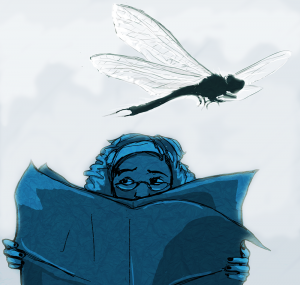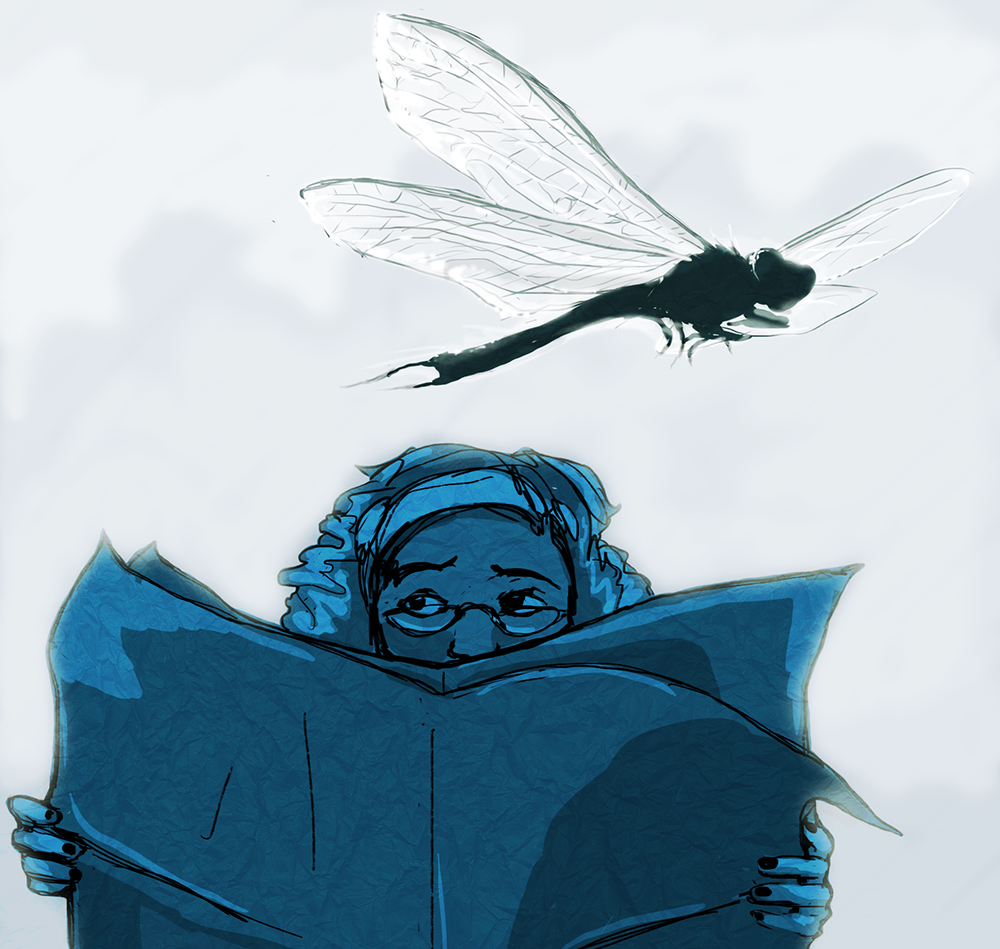An essay by Dr. Gertrude Nehmeyer, as provided by Simon Kewin
Art by Leigh Legler
In the summer of 2013, I was researching the history of Britain’s secret services in the Second World War for a magazine article. In particular, as a biologist, I was interested in the deployment of animals in the war effort. But among the discussions of carrier pigeons used to convey encrypted messages and dogs accompanying troops to act as guards and bloodhounds, I stumbled upon something truly remarkable: brief mention of a previously unknown–and huge–species of dragonfly.
At first I assumed the paper in question had simply been misfiled. But then I found a fuller report, which appeared to corroborate the story. The report referred to the species as Anax britannica, described as “similar to, although larger than, Anax imperator, the Emperor Dragonfly.” While imperator and its ilk are, of course, an ancient order of insect, britannica’s entire life history appears to have spanned just three years: the period 1941-1944. Unlikely as it may seem, the report suggested that swarms of these vast, clattering insects were Britain’s unlikely response to the deadly V1 flying bombs and V2 flying rockets that so terrorised southern England during World War II. Indeed, the paper referred to the insect as “Britain’s answer to the Nazi doodlebug menace.”
The report was accompanied by a single black-and-white photograph which does, indeed, depict a large dragonfly. It is hard to be sure, but judging by the foliage upon which the dragonfly perches, it is certainly possible Anax britannica’s wingspan reached the reported 12 inches. If this was so, it was the largest dragonfly to have flown over the face of the Earth for many millions of years–since the Meganeura dragonflies of the Carboniferous period, which had wingspans twice even this size.
The story seemed so incongruous and unlikely that I had to delve deeper. This was the start of a two year long trail of research and investigation which allowed me, finally, to piece together the remarkable story of one Dr. Henry Lamplighter. My article on pigeons and dogs was never written.

And that might be the end of the story, except for intriguing reports emerging in the years after the war of “large” or even “titanic” dragonfly sightings.
To read the rest of this story, check out the Mad Scientist Journal: Summer 2016 collection.
Dr. Gertrude Nehmeyer is an author, blogger, and broadcaster. She is Visiting Professor of Bioethics at the University of Southern England. She is the author of several best-selling books of popular science including The Dinosaur in the Treetops, Dan’s DNA, and Beetlemania. In her spare time, she plays in an all-woman ukulele band called Msbeehaving, available for bookings all across the London area.
Simon Kewin is the author of over 100 published short stories. His works have appeared in Nature, Daily Science Fiction, Abyss & Apex, and many more. He lives in England with his wife and their daughters. His cyberpunk novel The Genehunter and his “steampunk Gormenghast” novel Engn were recently published. He is currently completing his Cloven Land fantasy trilogy. Find him at simonkewin.co.uk.
Leigh’s professional title is “illustrator,” but that’s just a nice word for “monster-maker,” in this case. More information about them can be found at http://leighlegler.carbonmade.com/.
“Anax Britannica” is © 2016 Simon Kewin.
Art accompanying story is © 2016 Leigh Legler.

I’ll be keeping an eye out for these when camping next weekend. I think a campaign for a posthumous knighthood for Dr. Henry Lamplighter should begin at once!